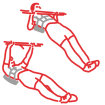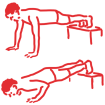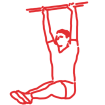Dead Hang. How-to, proper form and tips

Hang in a bar and stay there, holding with your arms straight. This is the Dead Hang.
Stretching all upper body is refreshing, and the exercise will help your shoulders, forearms and grip capacity. While hanging, keep your core relaxed. This is the main difference to the Active Hang.
Video demonstration
(excerpt from 'The Dead Hang' by Testosterone Nation)
by Testosterone Nation)
How to and step by step instructions:
- Stand on a box or chair in a way that you can easily hold the bar.
- Hold the bar with your hands facing away from you, overhand grip.
- Move your feet of the chair and suspend yourself.
- Keep your arms straight, in a relaxed position.
- Hold for a given amount of time. Count the seconds.
- Slowly step in the chair where you started and release your arms.
Hints & tips:
- Keep your arms dead straight, aim for the relaxed position.
- Stay still, avoid balancing.
- Stop before exhaustion, better repeat than exhaust.
Benefits:
- Stretch and decompress the spine.
- Offers strong grip and forearm gains.
- Stretch the upper body.
- Relieve shoulder pain.
- Increase range of motion of the shoulder.
- Posture.
Counting & gamification:
- Count the seconds for each rep, count progress by the number of consecutive seconds.
- Define an amount of time in minutes, accumulated, to hang in a given period (day, week or weekend).
- Hang a little every time you pass near a suitable bar.
- You should do 3 to 5 attempts with 30+ seconds each. Slowly increase this time.
Muscles worked and body parts involved:

Primary muscles: Shoulder, Forearms, Hand
Other names
The exercise can be found with other names. Examples are:
- Dead Hang
- Passive Dead Hang
- Dead Hang Pull Up Bar
- Passive Dead Hang Pull Up Bar
- Passive
Pull-up progression

1. Dead Hang



















